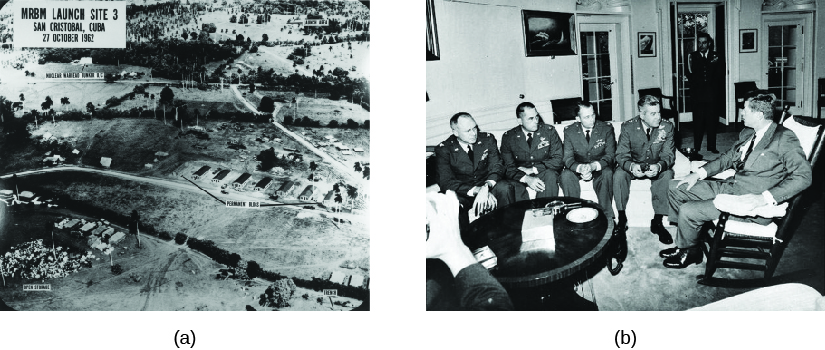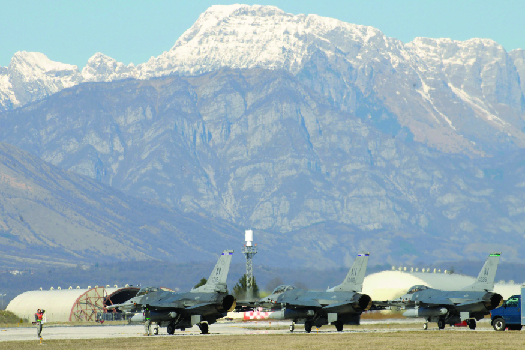| << Chapter < Page | Chapter >> Page > |
Perhaps the most famous foreign policy emergency was the Cuban Missile Crisis in 1962. With the Soviet Union placing nuclear missiles in Cuba, just a few hundred miles from Florida, a Cold War standoff with the United States escalated. The Soviets at first denied the existence of the missiles, but U.S. reconnaissance flights proved they were there, gathering photographic evidence that was presented at the UN ( [link] ). The Soviets stood firm, and U.S. foreign policy leaders debated their approach. Some in the military were pushing for aggressive action to take out the missiles and the installation in Cuba, while State Department officials favored a diplomatic route. President John F. Kennedy ended up taking the recommendation of a special committee, and the United States implemented a naval blockade of Cuba that subtly forced the Soviets’ hands. The Soviets agreed to remove their Cuban missiles and the United States in turn agreed six months later to remove its missiles from Turkey.

Listen to President Kennedy’s speech announcing the naval blockade the United States imposed on Cuba, ending the Cuban Missile Crisis of 1962.
Another form of focused foreign policy output is the presidential summit. Often held at the Presidential Retreat at Camp David, Maryland, these meetings bring together the president and one or more other heads of state. Presidents use these types of summits when they and their visitors need to dive deeply into important issues that are not quickly solved. An example is the 1978 summit that led to the Camp David Accords, in which President Jimmy Carter, Egyptian president Anwar El Sadat, and Israeli prime minister Menachem Begin met privately for twelve days at Camp David negotiating a peace process for the two countries, which had been at odds with each other in the Middle East. Another example is the Malta Summit between President George H. W. Bush and Soviet leader Mikhail Gorbachev, which took place on the island of Malta over two days in December 1989 ( [link] ). The meetings were an important symbol of the end of the Cold War, the Berlin Wall having come down just a few months earlier.

Another focused foreign policy output is the military use of force. Since the 1941 Pearl Harbor attacks and the immediate declaration of war by Congress that resulted, all such initial uses of force have been authorized by the president. Congress in many cases has subsequently supported additional military action, but the president has been the instigator. While there has sometimes been criticism, Congress has never acted to reverse presidential action. As discussed above, the War Powers Resolution clarified that the first step in the use of force was the president’s, for the first sixty days. A recent example of the military use of force was the U.S. role in enforcing a no-fly zone over Libya in 2011, which included kinetic strikes—or active engagement of the enemy—to protect anti-government forces on the ground. U.S. fighter jets flew out of Aviano Air Base in northern Italy ( [link] ).

The final example of a focused foreign policy input is the passage of an emergency funding measure for a specific national security task. Congress tends to pass at least one emergency spending measure per year, which must be signed by the president to take effect, and it often provides funding for domestic disasters. However, at times foreign policy matters drive an emergency spending measure, as was the case right after the 9/11 attacks. In such a case, the president or the administration proposes particular amounts for emergency foreign policy plans.
U.S. foreign policy outputs vary considerably. At one end of the continuum are sharply focused outputs such as the presidential use of military force via a specific drone strike on an enemy target, or the forging of a presidential summit with another country’s president or head of state. At the other end of the spectrum are broadly focused outputs that typically bring more involvement from the Congress and other world leaders, such as the process to formalize a multilateral treaty on the global environment or the process to finalize the U.S. diplomatic budget each fiscal year. Broadly focused outputs typically take more time to decide, involve more nation-states, are more expensive, and are quite difficult to reverse once in place. Sharply focused outputs are faster, tend to be led by the president, and are easier for future policymakers to undo.

Notification Switch
Would you like to follow the 'American government' conversation and receive update notifications?